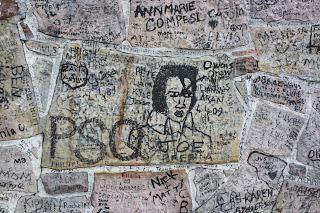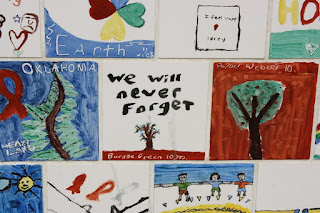Sunday, June 7, 2009
MY JOURNEY IS COMING TO AN END!
My amazing journey is nearing an end. I have been to so many different places, seen so many different things, and met so many wonderful, different kinds of people from all walks of life. I have been to the excess of Beverly Hills and to Indian Reservations where there is no electricity or running water. My experience was enlightening, educational, and a blast!
If I had to pick only one favorite place (besides the obvious national parks), it would be LaJolla, California. It is the most beautiful place I have ever seen and the charming seals just added to the allure! If I had to pick the place that had the biggest impact, it would be the memorial for the Oklahoma City bombing victims. Second would be seeing how Indians live on reservations.
And, if I had to do it all over again, the only thing I would change would be to make my journey longer! Maybe I'll do it again next year!
“Keep close to Nature's heart... and break clear away, once in awhile, and climb a mountain or spend a week in the woods. Wash your spirit clean.” ~ John Muir
Friday, June 5, 2009
KYMULGA GRIST MILL (Alabama)
 I have one last place I want to post. I was driving through a very remote area of Alabama, and came across a sign that read, “Covered Bridge--Turn Here.” I love covered bridges, so I turned. What I found was not only an amazing covered bridge, but two of the nicest people I have ever met. The covered bridge ended up being an old mill (still a working mill) called the Kymulga Grist Mill. It was built in the 1860’s and is located 4 miles northeast of Childersburg, Alabama. There is a very interesting history to it and it is on the National Register of Historic Places. The two lovely people I met sell the corn meal to the public and provide meal and grits to stores and shops. It was a very educational experience and I was so glad I stopped there. I have no idea what corn meal is used for, but I bought my father a bag of it! I just wanted to support this historic place.
I have one last place I want to post. I was driving through a very remote area of Alabama, and came across a sign that read, “Covered Bridge--Turn Here.” I love covered bridges, so I turned. What I found was not only an amazing covered bridge, but two of the nicest people I have ever met. The covered bridge ended up being an old mill (still a working mill) called the Kymulga Grist Mill. It was built in the 1860’s and is located 4 miles northeast of Childersburg, Alabama. There is a very interesting history to it and it is on the National Register of Historic Places. The two lovely people I met sell the corn meal to the public and provide meal and grits to stores and shops. It was a very educational experience and I was so glad I stopped there. I have no idea what corn meal is used for, but I bought my father a bag of it! I just wanted to support this historic place.Thursday, June 4, 2009
ELVIS!
As my travels continued onward, I found myself nearing Memphis, Tennessee. I had no intention of going through Memphis or visiting Graceland (love Elvis, but touring his home is not my kind of thing). As I drove, nearing the Tennessee line from Arkansas, an Elvis song came on the radio (my favorite one, no less)!!! I felt it was a sign from Elvis!! "Visit Graceland... visit Graceland!" What could I do?
This thing is a heart attack sitting on a plate! (OMG, it was soooo good!)
I did not go in the house, but I stopped at this Elvis diner to enjoy a fried peanut butter and banana sandwich (I am NOT kidding)!
This thing is a heart attack sitting on a plate! (OMG, it was soooo good!)
LITTLE ROCK NINE (ARKANSAS)
The Little Rock Nine is one of the most important events in the Civil Rights Movement. In 1957, a group of African-American students were enrolled in Little Rock Central High School in Arkansas. Despite the U.S. Supreme Court’s historic ruling in Brown v. Board of Education on May 17, 1954, declaring segregated schools unconstitutional, the students were prevented from entering the segregated school by Arkansas Governor Orval Faubus. Segregationist councils threatened to hold protests at Central High and physically block the black students from entering. Governor Faubus deployed the Arkansas National Guard to support the segregationists in preventing the Nine to enter the school. The sight of a line of soldiers blocking nine black students from attending high school made national headlines. President Dwight Eisenhower summoned Governor Faubus to meet with him. The President warned the governor not to interfere with the Supreme Court's ruling. After the intervention of President Eisenhower, the Little Rock Nine were allowed to attend the school, but it was never easy. They were taunted and harassed. One of the Little Rock Nine, Ernest Green, was the first African-American to graduate from Central High School. I visited Little Rock Central High School today. It is an historic landmark with a museum and visitor’s center; it is one of the best Civil Rights Museums I have been in, only second to the Lorraine Motel in Memphis.
This was a great Civil Rights Museum run by the National Park Service. It is across the street from the still-standing high school. It is free to enter.
This is Governor Faubus, who would not allow the Nine black students to go to school.
The Governor chose to ignore the Supreme Court's ruling and supported segregation.
He closed the school rather than let the Nine attend.
I loved this photo of a young Thurgood Marshall with the Little Rock Nine.
This was a great Civil Rights Museum run by the National Park Service. It is across the street from the still-standing high school. It is free to enter.
This is Governor Faubus, who would not allow the Nine black students to go to school.
The Governor chose to ignore the Supreme Court's ruling and supported segregation.
He closed the school rather than let the Nine attend.
I loved this photo of a young Thurgood Marshall with the Little Rock Nine.
Little Rock Central High School is still a working high school. It is very beautiful. This is what it looks like today.
There is a pond in the front of the school. Around the pond are nine benches, each engraved with the name of one of the Little Rock Nine.
This was a painting in the museum of the Nine kids being escorted by the National Guard.
Monday, June 1, 2009
OKLAHOMA CITY BOMBING MEMORIAL
On April 19, 1995, at 9:02 a.m., the Alfred P. Murrah Federal Building in Oklahoma City was bombed. I was honored to visit this memorial for the 168 victims, the survivors, and the rescuers. I would HIGHLY RECOMMEND that if anyone is any where near Oklahoma City, OK, that they visit the memorial and museum. It is run by the National Park Service.
This is one of the most beautiful and gut-wrenching memorials I have ever visited.
This is one of the most beautiful and gut-wrenching memorials I have ever visited.
This is the entrance. The inscription reads: "We come here to remember those who were killed, those who survived, and those changed forever. May all who leave here know the impact of violence. May this memorial offer comfort, strength, peace, hope and serenity."
The east gate represents 9:01 a.m., before the bombing. It signifies that the city was quiet, peaceful, and it was a beautiful day.
The west gate is inscribed with 9:03 when Oklahoma City was forever changed. There is a reflecting pool inbetween the two gates.
These chairs represent the 168 dead victims of the bombing (19 were children); each chair has a victim's name on the front. The ones for children are smaller.
This small one was particularly hard to look at. It belongs to a baby named Baylee. Her tiny, charred body being carried by a firefighter was pictured in newspapers all over the world.
The black granite to the left lists names of survivors of the bombing. The pathway was made from granite from the original building.
When they finally leveled the building, it was a mistake that this wall was left standing. But, they decided to use it in the memorial (a park ranger told me that).
This is the Survivor Tree. It is a 90-year-old American elm. Before the federal building was built, the area was a residential neighborhood. The tree survived the bombing and is a part of the memorial now.
Rescuers' Orchard. These trees surround the Survivor Tree. They are a thank you to the thousands of rescuers and volunteers who helped.
A church across the street was damaged. Instead of rebuilding it, the church created this "weeping Jesus". His back is to the memorial.
This is a fence around the building. For years people who visit the memorial have left their momentos.
Children's area. This wall was created from hand-painted tiles made by children from all over and sent to Oklahoma City.
Subscribe to:
Posts (Atom)





























































